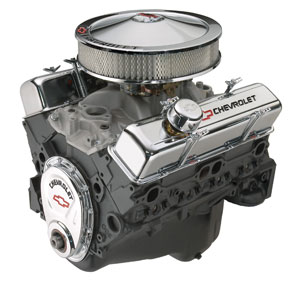 The Chevy small-block has been the quintessential American performance engine for more than half a century, but it was replaced by the “LS” engine family in production vehicles more than a decade ago. That means the pool of rebuildable cores is shrinking. In many cases, you just can’t be sure of the history of those remaining cores.
The Chevy small-block has been the quintessential American performance engine for more than half a century, but it was replaced by the “LS” engine family in production vehicles more than a decade ago. That means the pool of rebuildable cores is shrinking. In many cases, you just can’t be sure of the history of those remaining cores.
A reassuring alternative to rebuilding is a brand-new engine, and GM Performance Parts (GMPP) is the only source for all-new Chevy small-blocks. GMPP’s crate engines use brand-new cylinder blocks, heads and rotating assemblies – none of the components are reconditioned or machined. They also offer crucial advantages over old production engines, including the strength of four-bolt main bearing caps. Almost every used small-block core you’ll find online, in a salvage yard or at a swap meet will have two-bolt mains.
GMPP small-blocks are an affordable alternative to building performance into a rebuild, too, as even the entry-level 350-290HP (part number 12499529) engine delivers 290 horsepower and 332 lb-ft of torque. That’s more than almost every small-block offered in cars or trucks from the early 1970s through the late 1990s, making it a great, value-driven replacement for a 305-powered Monte Carlo or 350-powered truck. For example: On Oct. 5, 2010, the 350-290HP was offered for as low as $1,925 through Doylestown, PA, dealer Fred Beans on gmperformanceparts.com.
Rebuilding a small-block may be a time-honored tradition, but the stronger, more powerful and affordable crate engines from GM Performance Parts are great options for enthusiasts looking to re-power their project quickly – and without the nagging thoughts of the engine’s history. Go to gmperformanceparts.com for more information.













